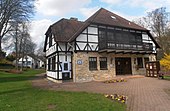Green plan
|
Green plan
Spots Delligsen
Coordinates: 51 ° 57 ′ 17 " N , 9 ° 44 ′ 42" E
|
|
|---|---|
| Height : | 178 (172-250) m |
| Residents : | 2421 (Jan 11, 2013) |
| Incorporation : | April 1, 1974 |
| Postal code : | 31073 |
| Area code : | 05187 |
Green Plan is the district of the borough Delligsen in the district of Holzminden , Lower Saxony . The district is located in a valley basin of the Hils low mountain range in a wooded area and is also known as the “ glassmaker's place ” due to its craft history .
history
The Brunswick Duke Karl I had the Fürstliche Spiegelglashütte built on the Green Plan in 1744 as part of the mercantilist population and economic policy he was pursuing , named after a local forest meadow of the same name. Almost simultaneously with the Schorborn glass factory, a glassworks for hollow and sheet glass was built in Schorborn am Solling, and a glassworks for bottles in Holzen am Ith with the Holzen glass factory . Forerunners of these glassworks were forest glassworks in Hils, such as the forest glassworks under the Hilsborn and the forest glassworks on the Glasebach .
Grünenplan emerged in 1749 from the planned workers' settlement of the Spiegelglashütte, which the forestry and chief hunter Johann Georg von Langen founded as a "new addition to the Green Plan". Under his direction, the art of mirror casting was also carried out in Grünenplan in 1752/1753.
As a result of the rival mirror glass works Amelith near Bodenfelde on the Hanover side, which was built from 1774 to 1776 , Grünenplan got into an economic crisis that almost brought the company to a standstill.
The Spiegelglashütte, founded in 1744, later became the Gebr. Koch'sche Glasfabrik and in 1871 the Grünenplan plant of Deutsche Spiegelglas AG (DESAG), which later became a subsidiary of Schott AG . It is the oldest plant in the glass manufacturing industry in Lower Saxony. In 1965, DESAG employed over 1,500 people in the Grünenplan plant, while the community had 3,200 inhabitants.
The trade in canaries in Grünenplan was also important . In 1860, Ludwig Ruhe (1828–1888) created the mainstay for his pet shop in the community. Between 1866 and 1869, the company established branches in Lima, New York (Manhattan) and London. In 1882, the company moved to Kalandstrasse in Alfeld . Later continued by Hermann Ruhe and Hermann Ruhe jr. the company went bankrupt in 1993.
On April 1, 1974, Grünenplan became a district of the Delligsen area as part of a regional reform with the previously independent municipalities of Delligsen, Hohenbüchen and Kaierde .
Spiegelglashütte on the Green Plan around 1860 as Gebr. Koch'sche Glasfabrik (brown)
Attractions
Two glass museums can be visited in Grünenplan: the Erich Mäder Glass Museum and the associated glassmaker's house . There is an ev.-luth. Church.
politics
Local council
The local council Grünenplan consists of 11 local council members and three council members from the locality Grünenplan (with an advisory vote). Since the local election on September 11, 2011 , this has been composed as follows:
Local mayor
The local mayor is Markus Oppermann (SPD).
Personalities
Sons and daughters of the church
- Heinrich Tønnies (1825–1903), photographer
- Ludwig Ruhe (1828–1888), German animal dealer and entrepreneur, with foreign companies at times one of the largest animal trading companies in the world
- Ferdinand Koch (1832–1904), hut owner and member of the Reichstag ( National Liberal Party )
- Arnold Busch (1876–1951), German painter and graphic artist
- Wilhelm Schierhorn (1886–1968), German military musician, music inspector for the German police and composer of police marches
- Ludwig Pahl (1872–1948), forest worker, politician ( USPD ) and member of the Braunschweig Parliament 1920–1922
- Konrad Peek (1881–1926), businessman, politician ( SPD ) and member of the Braunschweig Parliament from 1924–1926
- Mike Rose (1932-2006), German painter and writer
- Sabine Tippelt (* 1961), politician ( SPD ) and member of the Lower Saxony state parliament
Personalities who have worked on site
- Georg Althaus (1898–1974) was a pastor in Grünenplan
literature
- 250 years of the Green Plan. Contributions to local history . 1994 Green Plan
Web links
- The glassmaking site Grünenplan on delligsen.de
- Brief portrait on weserbergland.com
- Green plan on www.weserbergland-tourismus.de
Individual evidence
- ↑ Quiet pet shop
- ^ Federal Statistical Office (ed.): Historical municipality directory for the Federal Republic of Germany. Name, border and key number changes in municipalities, counties and administrative districts from May 27, 1970 to December 31, 1982 . W. Kohlhammer GmbH, Stuttgart / Mainz 1983, ISBN 3-17-003263-1 , p. 212 .



